Residential Roofing vs Commercial Roofing: Key Differences You Need to Know
When it comes to protecting your property, your roof plays a crucial role. But did you know that residential roofing vs commercial roofing requires different considerations? The needs, materials, installation processes, and maintenance schedules differ significantly between homes and commercial buildings—especially in states in the southeast, where the weather can be harsh and unpredictable.
In this post, we’ll break down the key differences between residential and commercial roofing, helping you understand which type is best suited for your building and its unique needs. Whether you’re a homeowner in Georgia or a business owner in Louisiana, understanding the differences is essential.
1. Roof Design: Residential vs Commercial Roofing
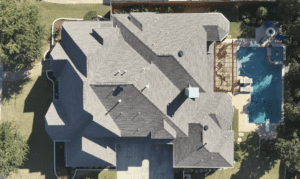
Multiple pitches visible on a residential roof.
Residential Roofing
Residential roofs are typically designed with steep slopes to encourage water runoff. These roofs can be aesthetically driven, as they often enhance the curb appeal of the home. Materials like asphalt shingles, tile, and metal panels are common for residential roofs, which are often built for visual appeal and practicality. If you live in a mid-century home with a low-slope or flat roof, you will need to follow a combination of the advice below. Don’t worry, just call us for advice!
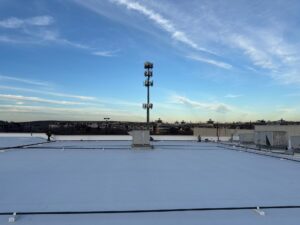
Flat, flat, mega flat.
Commercial Roofing
In contrast, commercial roofing is designed for practicality and durability. Commercial roofs tend to be flat or low-slope, maximizing usable space and allowing for easy installation of HVAC units, solar panels, or other equipment. Flat roofs are often more cost-effective for large buildings, such as office buildings, warehouses, and retail spaces.
Residential vs Commercial Roof Designs: Key Differences
2. Roofing Materials: Residential Roofing vs Commercial Roofing
The choice of materials for residential roofing vs commercial roofing differs based on function, durability, and cost.
Residential Roofing Materials
- Asphalt Shingles – The most common choice due to their affordability and variety.
- Clay or Concrete Tiles – Known for durability and aesthetic appeal.
- Wood Shakes – Often used for a more rustic look but require maintenance.
Commercial Roofing Materials
- TPO (Thermoplastic Polyolefin) – Popular for its energy efficiency and heat-reflective properties.
- EPDM (Ethylene Propylene Diene Monomer) – Rubber roofing that’s durable and ideal for flat roofs.
- PVC (Polyvinyl Chloride) – Known for its chemical resistance and long lifespan.
- Built-Up Roofing (BUR) – A multilayer system ideal for flat commercial roofs.
- Spray Polyurethane Foam (SPF) – Provides seamless insulation and weather resistance.
Commercial roofs are often designed to handle larger loads and resist weathering caused by exposure to heavy rain, extreme heat, (lookin’ at you, Central Texas) and UV rays.
Residential vs Commercial Roof Designs: Key Differences
3. Durability and Weather Resistance
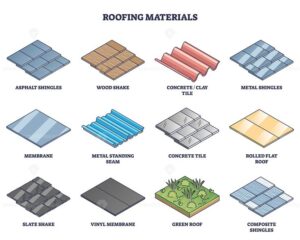
Quick visual guide to common roofing materials.
In regions like Georgia, Louisiana, and Texas, weather is a major factor in choosing the right roofing system. Residential roofing vs commercial roofing comes into play here because commercial roofs are built to endure harsher weather conditions.
Residential Roofing Durability
Residential roofs are generally designed to withstand rain, wind, and heat, but they are not as durable as commercial roofs. Materials like asphalt shingles typically last 15–25 years with proper maintenance, depending on climate and weather exposure.
Commercial Roofing Durability
Commercial roofs are built to handle more extreme conditions. With their flat or low-slope design, they must endure more standing water, UV exposure, and temperature fluctuations. Materials like TPO, EPDM, and PVC are specifically designed for greater durability, lasting 20–40 years or longer, depending on the material andclimate.
Residential vs Commercial Roof Designs: Key Differences
4. Installation and Maintenance: Residential vs Commercial Roofing
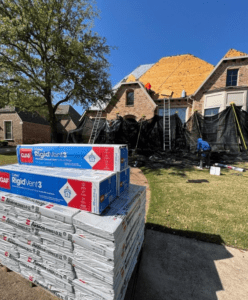
Residential roof installation in progress.
Residential Roofing Installation
Installing a residential roof is generally quicker and more straightforward. Roofers typically work on a single roof type—shingles or tiles—and the installation process is usually completed in a few days (though Roof Experts loves a one-day brag!), depending on the size of the house. Regular maintenance includes gutter cleaning, inspecting for leaks, and replacing damaged shingles.
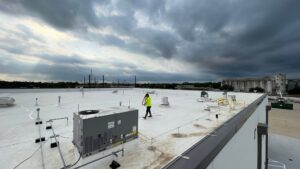
Commercial roofing installation.
Commercial Roofing Installation
Commercial roof installations are far more complex. Given the size of the building and the materials used, the installation process can take longer and requires specialized knowledge. Commercial roofs also need regular maintenance, including inspections for leaks, drainage issues, and cleaning of roof-mounted equipment.
In the Southeast, where storms, high humidity, and extreme heat are common, commercial roofs require more frequent inspections and maintenance to prevent issues like water pooling, mold, and premature wear.
Residential vs Commercial Roof Designs: Key Differences
5. Cost Differences: Residential Roofing vs Commercial Roofing
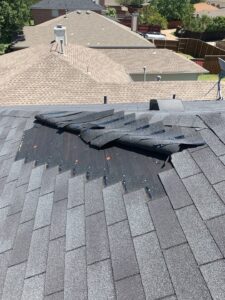
Residential roof undergoing maintenance- a great way to protect your investment.
When it comes to the cost of installation and materials, residential roofing vs commercial roofing can vary widely.
Residential Roofing Costs
Residential roofing tends to be less expensive due to the smaller scale and simpler materials. Asphalt shingles are the most cost-effective option, though other materials like tile or metal can increase costs. Installation is typically completed faster, lowering labor costs.
Commercial Roofing Costs
Commercial roofs are more expensive due to the larger scale and specialized materials required for durability and weather resistance. The installation can take longer, and commercial roofing systems often need extra layers or reinforcements for added protection against the Southeast’s harsh climate. However, commercial roofs tend to have a longer lifespan, making the investment worthwhile in the long run.
Residential vs Commercial Roof Designs: Key Differences
6. Roofing Systems for Southeast U.S. Weather


The weather in the Southeastern U.S. plays a significant role in choosing the right roofing system. Both residential and commercial roofing need to be designed to handle the high humidity, frequent rain, and intense heat common in states like Louisiana, Georgia, and Texas.
Residential Roofing
- Asphalt shingles are a common choice due to their affordability and versatility, but in humid climates, they may require more frequent replacement due to mold and algae buildup.
- Metal roofing is becoming increasingly popular for residential properties due to its durability and energy efficiency in the Southeast heat.
Commercial Roofing
- TPO and PVC membranes are often used in commercial roofing because they are energy-efficient and provide excellent protection against the Southeast’s hot summers and heavy rains.
- EPDM roofing is another common choice for commercial buildings in the region, offering long-lasting protection against moisture and UV damage.
Conclusion: Which Roofing Is Best for You?
Whether you’re considering a new roof for your home or your commercial property, understanding the key differences between residential roofing vs commercial roofing is essential for making an informed decision. The materials, durability, cost, and maintenance requirements differ based on your property’s needs and location.
If you’re looking for expert guidance on choosing the right roofing system for your Southeast U.S. property, our team is here to help. We specialize in both residential and commercial roofing solutions, ensuring your property is protected for years to come.
Contact Us for Your Roof Inspection Today!
Ready to learn more about the best roofing options for your property? Schedule a free roof inspection today and let us help you protect your home or business with the right roofing solution.
Follow us on Instagram for more of our projects and fun facts!
View this profile on Instagram


